The Chinese were clothed in Army fatigues and carried blankets. By pre-arrangement on their first night at sea, the Chinese ripped, shredded or discarded their clothing in order to arrive at Panmunjom clothed in rags and so visible to the world press.
- Chosin Few Marine
Dana A. Smith was born on November 23, 1925, in Hollis, Maine. He enlisted in the Navy V-12 Program upon graduation from high school in 1943, first attending Bates College and then Yale University, completing the program and receiving his commission in 1946. In 1952, he was recalled to active duty as LTJG and served on the LST 1084 until 1954, first as Engineering Officer and then as Executive Officer. The 1084 did a lot of traveling during that tour, carrying supplies to United States bases on various Korean islands, along with amphibious training exercises with the Army, Marines, and Seabees from the Kerama Rettos to Japan and Korea. The 1084 participated in the prisoner of war exchange operation "Big Switch."
In 1954, Smith returned to teaching in various Maine high schools, retiring in 1986. Both his service time and teaching career were quite uneventful, except for the day when he was Principal/Teacher in a small high school on a Maine ssland, and the State Police arrived to took away his assistant. The man turned out to be Ferdinand (Fred) Demara, "The Great Imposter." Smith married the former Flora Pearse. They have four children and seven grandchildren. At the time of this writing, his mailing address is P.O. Box 101, Tenants Harbor, Maine 04860.
June 1953. The prolonged wrangling over the prisoner-of-war exchange method of Panmunjom seemed about over. In the days and months that followed, LST-1084 and sister LSTs 1101, 1090 and 1073 in Division 34 would be participating in the massive P.O.W. exchange between North and South Korea, picking up or disembarking returnees from the islands of Cheju Do, Koje Do, Pongam Do, Yongcho Do and Chogun Ri. The P.O.W.s would be on board an average of two days and nights. In a typical sequence for LST-1084, she would onload P.O.W.s and guards at an island camp and depart about noon, arriving at Inchon late the next day and disembarking her P.O.W.s the following morning. After cleaning out the prisoner holding pens, she would then take on returnees from the northern prison camps and offload them at a now-vacant island camp. The sequence would be repeated, with LST-1084 then returning to Sasebo, Japan, for supplies.
On August 4, the ship took aboard her first load of prisoners-300 Chinese at Cheju Do. The prisoners would be held in 10 pens of 30 men each. The Chinese were clothed in Army fatigues and carried blankets. By pre-arrangement on their first night at sea, the Chinese ripped, shredded or discarded their clothing in order to arrive at Panmunjom clothed in rags and so visible to the world press. Offloading at Inchon could be difficult. Since tides and currents in Inchon Harbor are tremendous, it was not always possible to beach an LST on schedule, and prisoners were taken ashore in LSUs to be put immediately on trains for Panmunjom. On one of LST-1084's trips-this one with North Korean P.O.W.s-the ship arrived at Inchon to find that heavy rains had washed away some of the rail lines from Inchon to Panmunjom. Since there were no camp facilities at Inchon, the prisoners were forced to stay onboard for an extra night while the rail lines were being repaired. This was mass transit for unfriendly people under primitive conditions, and the additional hours spent onboard were not pleasant. There was no exposure to fresh air, and no daily exercise. There was one issue of cooked rice per day - equivalent to two meals, if the P.O.W.s rationed it. Oil drums served as latrines-one to each holding pen-and straw mats were used as bedding. Prisoners emptied their "honey buckets" at sea.
When LST-1084 took aboard her first load of North Koreans, crewmen found them to be cleanly uniformed, militaristic and under the immediate command of their own officers. At one stop-Pongam Do-the P.O.W.s marched to the bow doors in groups of 30, stopped and underwent inspection, then listed to exhortations from their officers and had a group picture taken. P.O.W. leaders then met in the wardroom with the 1084's commanding officer for a briefing on the details of the trip. Returnees from the northern prison camps-ROK troops-were permitted more freedom aboard ship and could come up to the main deck during daylight hours. ROK guards supervised the returnees, who were not allowed aft on the main deck because of possible Communist infiltrators. During LST-1084's first trip with returnees, the ship's mess made an attempt to upgrade the type of diet that had been provided for Communist P.O.W.s. After one day of a more-varied diet, word was sent by an interpreter that the men preferred less variety and more rice. LST-1084 discharged her last returnees September 6, made some supply runs to various Korean ports, went to Yokosuka for repairs, arriving in San Diego November 23.
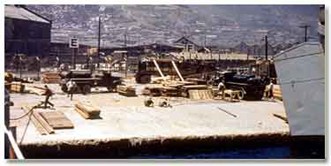 The picture at right was taken at Pusan, probably on June 14 or 15, 1953. At this time, the prolonged wrangling over the prisoner-of-war exchange method at Panmunjom seemed about over, and we were gearing up to be involved. The lumber on the quay was to be brought to the tank deck and P.O.W. pens constructed. We were to carry 300 prisoners.
The picture at right was taken at Pusan, probably on June 14 or 15, 1953. At this time, the prolonged wrangling over the prisoner-of-war exchange method at Panmunjom seemed about over, and we were gearing up to be involved. The lumber on the quay was to be brought to the tank deck and P.O.W. pens constructed. We were to carry 300 prisoners.
An LST is shaped somewhat like a hollow cigar (see below), 320 feet in length. Below the main deck, it is three levels high, with the tank deck occupying the top two of these in the interior of the ship. The lowest level, or hold, is taken up by the engine rooms, storage for fuel, water and ballast tanks.
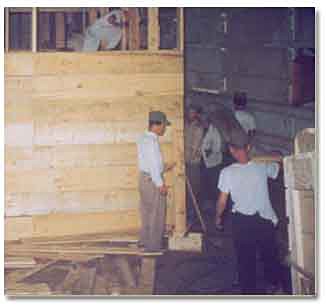
After the pens were constructed, we went back to Sasebo, Japan, and waited. Nothing progressed with the peace talks. We waited longer and did some traveling, which included a visit to Hagi on the west coast and a cruise completely around the island of Honshu. Finally, the Communists started an offensive and we ended back in Pusan on July 16.
As I remember, the pens were removed at that time. We picked up troops and equipment at Koje Do, took them to a place called Sokcho Ri, and returned to Pusan. This time, ten pens of thirty men each were constructed. (Originally, it had been fifteen pens of twenty men.) Then back to Sasebo to wait on July 23.
On August 3, we arrived at Cheju Do to take aboard 300 Chinese. We were in business!
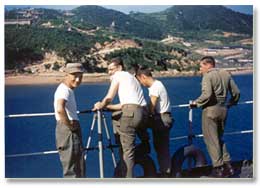
I regret that I did not record "Jim's" proper name and address. He was from Taiwan, of course, and had been working for the U.S. Army for years as an interpreter. Most of his time was free and so was a great deal of mine. We spent a lot of time in the wardroom, playing Casino. He was the only Oriental I ever met who understood American humor. He was an extremely likeable person.
Army MP outfits handled the P.O.W. guard duties. We would pick them up with the first lot of prisoners and leave them with the last group of returnees. They did not come to Sasebo with us between sequences and we would get a new group when we would start a new sequence.
Islands where we picked up P.O.W. or left returnees: Cheju Do, Koje Do, Pongam Do, Yongcho Do, Chogu Ri. ("Do" is Japanese for "island".)
Approximate running time-depending on weather, tides, etc: Pusan to Sasebo = 14-15 hours; Pusan to Cheju-do = 20 hours; Cheju Do to Inchon = 29 hours; Pongam Do to Inchon = 24 hours.
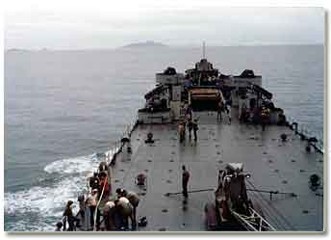 Our first lot of prisoners were Chinese from Cheju Do on August 4. This was a large camp and the only one I visited. I didn't see much, as I made my tour of the place with the duty officer in a jeep just before midnight. All was dark within the enclosures. There were lights along the roads, so you could tell whether or not the men were inside their barracks, but that was all. As long as they stayed within their enclosures, I guess the prisoners just about controlled their own destinies. (Not much like the enemy camp experiences.) They drilled with fake guns, practiced "self-defense", and laughed at the guards (from a distance). When the duty officer spoke about questioning prisoners as to the extent of their Communist leanings, I asked him how he could tell if a P.O.W. was really a Communist. His reply was, "If they spit in your face, they're Communist." The Chinese came onboard clothed in Army fatigues and carrying blankets. On the first night out, by pre-arrangement, they ripped, shredded and/or discarded their clothing by throwing the articles into the oil drums that served as latrines in the pens. The same thing was happening on all the other ships. Thus they would arrive at Panmunjom in rags, visible to the world press. Most of them kept their shoes, hats and blankets intact, however.
Our first lot of prisoners were Chinese from Cheju Do on August 4. This was a large camp and the only one I visited. I didn't see much, as I made my tour of the place with the duty officer in a jeep just before midnight. All was dark within the enclosures. There were lights along the roads, so you could tell whether or not the men were inside their barracks, but that was all. As long as they stayed within their enclosures, I guess the prisoners just about controlled their own destinies. (Not much like the enemy camp experiences.) They drilled with fake guns, practiced "self-defense", and laughed at the guards (from a distance). When the duty officer spoke about questioning prisoners as to the extent of their Communist leanings, I asked him how he could tell if a P.O.W. was really a Communist. His reply was, "If they spit in your face, they're Communist." The Chinese came onboard clothed in Army fatigues and carrying blankets. On the first night out, by pre-arrangement, they ripped, shredded and/or discarded their clothing by throwing the articles into the oil drums that served as latrines in the pens. The same thing was happening on all the other ships. Thus they would arrive at Panmunjom in rags, visible to the world press. Most of them kept their shoes, hats and blankets intact, however.
In the picture above, taken the second day out, a group of Chinese was washing mess gear in a GI can, under a guard's supervision. One of our sailors is manning the hose. A squad of guards is being inspected further on, preparatory to going down the truck ramp to the tank deck and relieving those on duty.

Tides and currents in Inchon Harbor are tremendous, so it was not always possible to beach an LST at the desired time. Larger ships were even more restricted. As a result, prisoners were taken ashore in LSUs on schedule and put immediately on trains for Panmunjom. Transferring was done as quickly as possible, with prisoners encouraged to hurry along.
The scene was so typical of that type of situation, one felt he was watching history repeat itself for the millionth time: The heavy-handed guard (in this case, the one at the entrance with the soft hat), prisoners sensing that being in the middle of the group is better than being on either end, where an Army boot in the butt or a cuff across the head was apt to be the reward, others trying to retain a sense of self-pride by refusing to trot (or scurry), even though they knew that the result would be at the "thump point." Woe to the few men who had thrown away their shoes in the demonstrations. The "thump" would be a stamp on the toes when they tried to skip past.

It was obvious that some of the provisions of the Geneva Convention concerning P.O.W. treatment were not going to be observed during the sojourn on our ship. There was no exposure to fresh air and exercise daily. There would be one issue of cooked rice per day and the supply was sufficient to be equivalent to two meals if they wanted to ration it that way among themselves. Our galley was used for P.O.W. cooking during off-hours (mainly the early morning hours).
Oil drums cut in half served as latrines, one to each pen. While underway during the day, the ship would slow down, the bow doors opened, the ramp lowered and these "honey-buckets" would be emptied. The stench in the tank deck must have been impressive, to say the least. The superstructure of an LST is all aft, with the tank deck ventilators discharging right in front of it.
The smells hit you almost in the face when you were on the control tower underway. It took a while at the beginning of a four-hour watch to get used to it. It must have been much the same (only worse) for the guards when they changed shifts.
As for the P.O.W.? The 48 hours they spent on board were certainly not pleasant ones. It was mass transit for unfriendly people under primitive conditions. One can only imagine prison ship conditions over a long period of time. A Marine acquaintance of mine in 1952, who had spent all of World War II as a Japanese prisoner, told me of some of the times in the camps, with the exception of those weeks he spent in the hold of a Japanese transport traveling from the Philippines to Japan. He just said, "That was a story all by itself," and I dropped the subject. One should read the recently published (1982) accounts by the survivors of the Bataan Death March. Over two months in iron holds, with no toilet facilities other than a bucket on a rope, no bedding or ventilation, little food and men dying hourly.
As the buckets contained many articles of clothing discarded during the demonstrations, the whole affair was being recorded by the photographer at right. The big, bareheaded sergeant got heavy-handed at times, and had to be warned off by a nearby Lieutenant. The broad-shouldered prisoner at the lower left had discarded all but his undershorts and boots. He was one of those trying to retain a "self-image", and you could sense the air of challenge when he brought the bucket to the ramp edge. Not surly. Not rebellious. Just independent.
As I was not "authorized", the taking of these pictures and all the others was an illegal act on my part. Sometimes an Army officer would try to wave me off, but I was always up on the main deck level and not easy to get at! The realization that I was one of the ship's officers made it difficult for him to send someone after me. Besides, he would be too quickly occupied by other matters at hand to be persistent.
Koje-Do, one of the largest camps, housed North Koreans. From a distance, it looked huge and dusty in the August heat. Earlier in the war, the American General in charge of the camp got careless and was taken hostage by the prisoners. Once he was released, he was transferred elsewhere.
Straw mats were used as bedding. At the end of each trip, the old mats would be taken to the fantail to be dumped overboard as soon as we got out to sea. New ones would be brought to the tank deck.
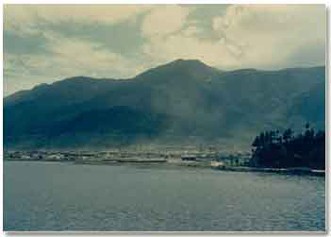 On one of our trips with North Koreans, we arrived at Inchon to find that heavy rains had washed away some of the rail lines from Inchon to Panmunjom. There being no camp facilities for POW at Inchon, the prisoners were forced to stay onboard for an extra night while the lines were being repaired. When they received the good news, they set up quite a hubbub. The Army guards, not adverse to taking advantage of the opportunity, quickly tossed tear gas canisters into the pens. In contrast to the raggle-taggle Chinese, the North Koreans were clean-uniformed, militaristic, and under the immediate command of their own officers. I recorded in my diary that at Pongam Do, the groups marched to the bow doors in groups of thirty. Here they would stop, undergo inspection, listen to exhortations, and have a group picture taken.
On one of our trips with North Koreans, we arrived at Inchon to find that heavy rains had washed away some of the rail lines from Inchon to Panmunjom. There being no camp facilities for POW at Inchon, the prisoners were forced to stay onboard for an extra night while the lines were being repaired. When they received the good news, they set up quite a hubbub. The Army guards, not adverse to taking advantage of the opportunity, quickly tossed tear gas canisters into the pens. In contrast to the raggle-taggle Chinese, the North Koreans were clean-uniformed, militaristic, and under the immediate command of their own officers. I recorded in my diary that at Pongam Do, the groups marched to the bow doors in groups of thirty. Here they would stop, undergo inspection, listen to exhortations, and have a group picture taken.
Their leaders would meet in the wardroom with our C.O. and the MP officers. They would be told what the trip was going to be like. This meeting was held at the insistence of our LST Division Commodore, Commander MacRae, who felt that the Navy C.O. had to assume very positive command of his ship and not let the Army act at will. (Referred to them as Sadists!). Except for occasional hullabaloos, things went pretty well. I think this policy came about after the tear gas incident. There was no physical contact between the U.S. Army guards and the Koreans, as there had been with the Chinese. Politics? Sometime, I would like to know the answer.
As soon as we discharged our prisoners at Inchon, the pens would be cleaned and returnees from the Northern prison camps would come aboard. All our returnees were ROK (Republic of Korea) troops. We never carried American or other nationalities. I suspect that the larger ships had better facilities than those we had to offer!
These men could move about more freely and come up to the main deck during daylight hours. We carried ROK guards, who can be seen in the pictures. The returnees had to be supervised (guarded) and were not allowed aft on the main deck because of possible Communist infiltrators. We would offload them at island camps, where they would be formally received at the landing. There, their re-processing would begin.
During our first trip with returnees, there was an attempt to upgrade their diet over that which had been provided for the Communists. After one day, they sent word through an interpreter (we were carrying a young Korean Naval officer as a trainee at the time) that they preferred less variety and more rice. So much for our good intentions!
The above picture was taken in Inchon Harbor. It shows our control tower and a helicopter carrying Indian troops from the Harbor to Panmunjom. India was a neutral nation in the Korean War, so troops from that country were selected to carry out guard and supervisory duties at the Panmunjom exchange camps. Nothing about this arrangement was satisfactory to ROK President Syngman Rhee, who was opposed to the entire peace settlement because it called for a divided Korea. He declared that Indian troops were not to set foot on South Korean soil. Thus, the ferrying by air of the troops, once they arrived at Inchon.
We discharged our last returnees on September 6. The exchange was over, as far as we were concerned. The Navy began to send its ships home, and the business girls of Sasebo were forced to make adjustments in their living standards. We made some supply runs to various Korean ports, went to Yokosuka for repair work, and headed for the U.S. on October 23. On the first day out, the 1073 (our sister ship) developed problems and we had to turn back. Got going again on the 24th.
St. George - Dana A. Smith, 81, died peacefully at his home March 5, 2007, in the care and company of his loving and devoted family.
Born November 23, 1925, in Hollis, he was the son of Clementina (Tyler) Smith and Robert C. Smith. He graduated from Hollis High School in 1943 and at the age of 17 entered the Navy V-12 Program at Bates College.
After two semesters at Bates, he was sent to the Yale University V-12 program for six semesters of mechanical engineering. He received his ensign's commission at Yale in 1946, but because World War II had ended, never saw active duty until the Korean Conflict, when he served aboard the LST 1084 in Japan and Korea.
In the interim between training and wartime service, he completed his bachelor's degree in engineering at the University of Maine in Orono and later a master's degree in education. In January 1952, he married the former Flora Pearse of Hope.
He began his educational career as a classroom teacher at Dexter and Winslow high schools. He expanded his teaching role to include administrative duties as principal of North Haven High School in 1954 and St. George High School in 1957. When Georges Valley High School opened in 1962, he assumed the dual position of vice principal and math teacher. He retired from teaching at GVHS in 1986.
One of his top priorities and loyalties was his military experience and affiliations. He was a member of the Korean War Veterans Association and was officially recognized in 2005 for 60-year membership in the American Legion.
In 1984, he initiated what would become a yearly newsletter for all Bates "V-12ers." Its creation served to bring recognition to the significance of the program in the wartime years of the college as well as offer a forum for the veterans who participated to renew their friendships and share their memories. The Bates class of 1945 recognized his contributions by declaring him an honorary class member in 2005.
Civic-minded and service-oriented, he was actively involved in many local organizations and worthwhile causes. A loyal member of the St. George International Order of Odd Fellows, he worked tirelessly to support its precepts, valuing the close comaraderie of fellow members and serving the organization as treasurer for more than 20 years.
In addition, he was a dedicated member of the St. George Historical Society. His commitment to the preservation of local history fueled his efforts to help restore the Marshall Point Lighthouse and later establish the Lighthouse Museum. The compilation of numerous picture albums and displays housed at the museum reflect his love for photography and the role he believed it played in documenting the tangible richness of everyday life.
He is survived by his wife; his four children and their families: Billie and Paul Gaudette, their children, Jessica and Gabe, of St. George, Baxter and Melody Smith, their children, Tyler and Barrett, of Seaford, Del., Bonnie and David Beaulieu, their children, Ben and Zach, of Avon, Conn. and Bette and Alan Sturtevant, their children, Hannah, Isaac and Laura, of Oakland; a brother-in-law and his wife, William and Francina Pearse, of Hope; two nieces; two nephews; and several cousins.
Memorial donations may be sent to Bates College to the attention of Shanna Bruno, Bates College, 2 Andrews Road, Lewiston, ME 04240, made payable to Bates College and noting on the memo line, "In Memory of Dana Smith." Funds will be collected to establish a memorial project yet to be determined that will honor him and the V-12 Program. Donations also may be sent to the St. George Volunteer Firefights and Ambulance Association, P.O. Box 249, Tenants Harbor, ME 04860 or Jackson Memorial Public Library, P.O. Box 231, Tenants Harbor, ME 04860.
At his request, there will be no funeral services. Arrangements are with the Coast of Maine Cremation and Funeral Service, Waldoboro.